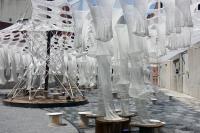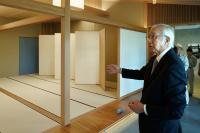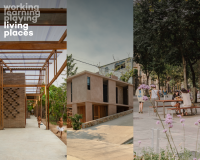Aqua House
Anjuna, インド
Aqua house deals with contemporary urban nomadic living conditions and the overwhelming landscape of Goa. The processes are further influenced by the predominant Portuguese house-form with its intriguing intricacies of lives beneath a single roof, and the location. The site forms a threshold: between the village and the beach and between social mooring and vagrancy – Anjuna being the cradle of the Hippy culture. The key-word here is in-between-ness: of site – it’s physical and cultural position; of the principle participants – neither the architect nor the clients being residents but frequent visitors to Goa, and habitual travellers in their own right; and of the program – a home away from home, not complete yet adequate. Vacations and pilgrimage attend to the need for a break from the binding matrix of society. By moving away from familiarity, or enduring hardships, one exposes the body and mind to all elements and opens out to receive more. In essence, one seeks a state of trance to rearrange; and this state is, necessarily, impermanent; so one may not break away but return replenished – to offer.
The uncomplicated plan is rationally nestled in the linear site with its short west-end facing the sea. The breakthrough, however, is in the language. Recessing the plinth to allow a substantial projection of the masonry surface above imparted buoyancy to the structure; and this discovery led to a severe reworking of the scheme, informing the distribution of volumes through the house and the necessary articulation and configuration of elements for the purpose. All services – kitchen, bath and toilets, servant’s quarter and store – are accommodated in the low arms of single storey masonry massing along the east and north edges of the plot, so as to buffer the inner living spaces from the traffic outside – a parking lot on the east and the right of way along the north edge for the visitors to the beach.
Adding to the intrigue of this opaque massing is a glazed slit opening, a little below the slab, running full lengths on both the arms. The slit climbs down to mark a comma on the long north face, growing into an enticing louvered window. A tower – containing the overhead water tank, air conditioning compressors and other utility – anchors the north-east vertex. An RCC lintel slab with thick inverted beams runs all along the building’s edge. It floats on RCC columns punctuating the south side of the living space, affording a large opening to the west. The fenestration renders further weightlessness to the building by reflecting the sky and the trees during day and imparting a filtered glow at night. A sweeping Mangalore-tiled gable roof, with a dramatic structure constructed purely out of wood, forms one large mass encompassing the inner living spaces; its rafters are braced with plywood to avoid obtrusive ties that would otherwise run across the spaces below. The large roof does not sit directly on the mass. Instead, it forms a sliver through a glazed wooden girder running all around its perimeter. Thus, in seeking a built form in trance, the earnest plan became intensely animated – offering varied scales and textures, light and vistas, and spaces.
The movement into the house, through a large entry door adjacent to the tower, gradually spirals through a passage, into a small arrival court, then through a porch, into a large one-and-half volume living/ dining space, then through one end of the kitchen bar, into the master bed-room, culminating in to an little introvert courtyard. At the threshold between the dining and kitchen a flight of stairs branches up, above the master bedroom, to another sleeping space overlooking the living/ dining space. The sliver frames a spectacular panorama of the sea and the horizon from this intimate space above. The movement branches out of the west end of the living into a courtyard, and exits the site – at the head of a small infinity pool - from the north-west corner to meet the path going down to the beach.
This beach house is made up of myriad fragments and yet does not break away; its shifting base, torso and head, strive to express a leap of joy, aware of but unperturbed by gravity.
- 場所
- Market Rd, 403509 Anjuna, インド
- 年
- 2008














